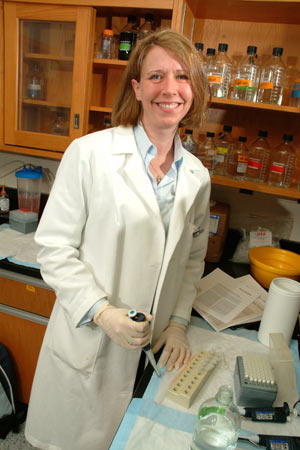
In her Larkin Hall laboratory, Melissa Henriksen, Ph.D., attempts to unravel the genetic mysteries of cancer.
Photo by Chris Taggart
Down in the basement of Larkin Hall on the Rose Hill campus, inside a cluster of laboratories, Melissa Henriksen, Ph.D., the Clare Boothe Luce Assistant Professor of Biological Sciences, is working to unravel a deep secret.
And she means unravel literally.
Henriksen studies the behavior of proteins called histones, which are lodged deep inside a cell, imprisoned by thousands of DNA strands, much like a spool surrounded by thread. The activity of these histone proteins is determined by chemical modifications to their tails. Some modifications lead to an unraveling of the DNA “spools,” and others to a tightening. When a damaged cell tries to send out an SOS to its neighboring cell, it is the DNA that must receive the message in order for the cell to activate the genes that trigger the appropriate defense mechanisms. The histone proteins must unravel to allow the message through.
Sometimes the histones don’t unravel: it is Dr. Henriksen’s quest to find out why. If she can discover how to open up the path to this blocked route of cellular communication, she said, it can help intervene when cell communication goes awry—as it does in many cancers and autoimmune diseases.
“Often in cancer, genes that are supposed to be off, are on, and vice versa, and you get hyper-proliferation of the cancerous cells. Sometimes it is not a genetic mutation, but an epigenetic mutation,” Henriksen said, epigenetic meaning “upon or in addition to the gene.” “By comparing how the process is regulated in normal situations and in cancerous situations, we can understand what is abnormal and find ways to think about controlling it. If, one day, we can turn on these genes that are inappropriately turned off, we can help slow down the proliferation of a tumor.”
Henriksen came to Fordham in 2005, after working as a post-doctoral researcher and then a staff scientist at the Rockefeller University with James E. Darnell Jr., M.D., an American biologist and recipient of the National Medal of Science, who has made significant contributions to the field of cellular biology. Here at Fordham, Henriksen is collaborating with Robert A. Ross, Ph.D., professor of biological sciences and chair of the department, on the epigenetic regulation of the cancer stem cells that cause neuroblastoma, a form of cancer most often found in young children and infants. Close to 50 percent of neuroblastoma cases occur in children younger than two years old.
The Clare Boothe Luce Fund, which sponsors Henriksen’s post at Fordham, was set up by the heiress and former congresswoman to help increase women’s participation in underrepresented areas of study. Fordham is one of 13 institutions that receive money from the Fund in perpetuity. In addition to doing research, Henriksen acts as mentor to two female graduate students, both Ph.D. candidates in biology, who are her assistants. The two women, Lauren Buro and Shaili Shah, won fellowships through the Department of Biological Science’s graduate program and chose to work with Henriksen on their Ph.D. research.
“Clare Boothe Luce broke down a lot of barriers in her many careers, and she wanted to fund something where those barriers were still in place,” Henriksen said. “I am committed to the mission of the Luce Foundation and I mentor my students with that in mind.”
Henriksen acknowledges a shortage of women in higher science positions at academic universities; she has experienced some subtle discrimination in her own career but recognizes more significant institutional barriers to women in science. Among her peers, she sometimes sees a “self-selection” out of the field among post-doctoral women when they reach child-bearing age, and feels that this one issue she can directly address in mentoring young women in science at Fordham.
In her experience, a major factor “that causes women not to pursue science careers is a conflict they see between family life and science,” said Henriksen, who recently had her first child. “For some reason, the notion that it is impossible to be a mother and a scientist seems extremely inflated in women’s minds. I try to lower that perception, to be an example and to show there are a lot of women who manage to do both. Getting past this myth does not solve all the problems but it is a start.”
One benefit of a Luce-funded professorship is that its recipients are allowed to apply the award for expenses beyond research, including, for example, child care costs.
“In that sense,” Henriksen said, “the Fund really does help promote women in science. It offers more support, it sees the big picture.”
Henriksen called the miniscule world of cells that she studiesthe “basis for the real world.” She teaches “Introductory Biology” and takes pleasure in showing her students the complexity and unity of biological life.
“I enjoy how biology peels apart how closely we are all related as organisms,” she said. “From humans to chimpanzees to the lowly baker’s yeast, we’re all connected. Some people find that threatening. I find it extremely inspirational.”
Henriksen will be speaking at Fordham’s upcoming seminar sponsored by the Center for Ethics Education, Embryonic Stem Cell Research: Moral Questions for the 21st Century, on April 17. She will speak on the topic of reprogramming adult stem cells and on the unique properties of embryonic stem cells.
– Janet Sassi
